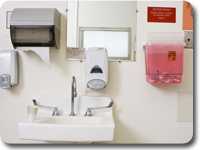Healthcare-associated Infections

At any given time, about 1 in every 25 patients has an infection related to their hospital care. Healthcare-associated infections (HAIs) not only affect patient lives, but also add to our growing healthcare costs. HAIs are commonly caused by antibiotic-resistant bacteria, which may lead to sepsis or death. One in seven catheter- and surgery-related HAIs in acute care hospitals, and one in four catheter- and surgery-related HAIs in long-term acute care hospitals, is caused by any of six resistant bacteria (not including C. difficile).
CDC has identified eliminating HAIs as a Winnable Battle. Progress has been made in preventing HAIs, including a 50% decrease in central line-associated blood stream infections from 2008 to 2014, but more work is needed. With additional effort and support for evidence-based, cost-effective strategies that we can implement now, we can have a significant impact on our nation’s health.
The HAI Winnable Battle materials below provide a snapshot of the context and background for this priority area, as well as descriptions of some of the systems, policy, and programmatic interventions pursued by CDC and our public health partners at the federal, state and local levels.
Prevent healthcare-associated infections (HAIs) – Final Report
1 out of 25 hospitalized patients contracts an HAI.
Healthcare-Associated Infection (HAI) Overview Materials:
- PowerPoint slides, which can be tailored for your use by adding specific data, case studies, and other useful information [PPT – 6.89MB]
- CDC map of investments to combat AR, an interactive web app with printable state- and city-specific fact sheets describing CDC’s work to tackle antibiotic resistance (AR) using fiscal year 2016 funds.
Vital Signs
- Vital Signs: Making Health Care Safer
Think sepsis. Time matters.
August 2016 [PDF – 1.75 MB] - Vital Signs: Making Health Care Safer
Protect Patients from Antibiotic Resistance
March 2016 [PDF – 3.12 MB] - Vital Signs: Making Health Care Safer
Stop Spread of Antibiotic Resistance
August 2015 [PDF – 2.10 MB] - Vital Signs: Making Health Care Safer
Antibiotic Rx in Hospitals: Proceed with Caution
March 2014 [PDF – 1.44 MB] - Vital Signs: Making Health Care Safer: Stop Infections from Lethal CRE Germs Now
Untreatable and hard-to-treat infections from CRE germs are on the rise among patients in medical facilities.
March 2013 [PDF – 1.62 MB] - Vital Signs: Making Health Care Safer, Stopping C. difficile infections
March 2012 [PDF – 1.25 MB] - Vital Signs: Making Health Care Safer, Reducing Bloodstream Infections
March 2011 [PDF – 2.44 MB]
For more information about the HAI Winnable Battle, please visit www.cdc.gov/hai/.
If you have questions about the materials provided here, please contact ppeo@cdc.gov.
- Page last reviewed: April 24, 2017
- Page last updated: April 24, 2017
- Content source:





 ShareCompartir
ShareCompartir